Wikipedia:Picture of the day/March 2023
|
Featured picture tools: |
These featured pictures, as scheduled below, appeared as the picture of the day (POTD) on the English Wikipedia's Main Page in March 2023. Individual sections for each day on this page can be linked to with the day number as the anchor name (e.g. [[Wikipedia:Picture of the day/March 2023#1]] for March 1).
You can add an automatically updating POTD template to your user page using {{Pic of the day}} (version with blurb) or {{POTD}} (version without blurb). For instructions on how to make custom POTD layouts, see Wikipedia:Picture of the day.
March 1

|
|
The Port Hills are a range of hills in the Canterbury Region of New Zealand, so named because they lie between the city of Christchurch and its port at Lyttelton. The hills are an eroded remnant of the Lyttelton volcano, which erupted millions of years ago. Starting at Godley Head, the range runs approximately east–west along the northern side of Lyttelton Harbour and thence to the south, terminating near Gebbies Pass above the head of the harbour. It includes a number of summits between 300 and 500 metres (980 and 1,640 feet) above sea level. This photograph shows a panoramic view of the Port Hills from Mount Ada, looking towards Lyttelton Harbour in the distance. Photograph credit: Michal Klajban
Recently featured:
|
March 2

|
Romanesco broccoli is an edible flower bud of the species Brassica oleracea. It is chartreuse in color, and has a form naturally approximating a fractal. When compared to a traditional cauliflower, it has a firmer texture and delicate, nutty flavor. Photograph credit: Ivar Leidus
Recently featured:
|
March 3

|
The Woman Suffrage Procession was a suffragist parade held in Washington, D.C., on March 3, 1913, the day before Woodrow Wilson's first presidential inauguration. It was organized by Alice Paul for the National American Woman Suffrage Association. Thousands of suffragists marched down Pennsylvania Avenue "in a spirit of protest against the present political organization of society, from which women are excluded". The march and the attention it attracted were important in advancing women's suffrage in the United States. This image shows the front cover of the official program of the Woman Suffrage Procession, illustrated by Benjamin Moran Dale. It depicts an elaborately dressed woman blowing a trumpet with a "Votes for Women" banner while riding on horseback in front of the United States Capitol. Illustration credit: Benjamin Moran Dale; restored by Adam Cuerden
Recently featured:
|
March 4

|
Isambard Kingdom Brunel (1806–1859) was an English civil and mechanical engineer. The son of French engineer Marc Isambard Brunel, he worked under his father as an assistant engineer on the Thames Tunnel project for several years until he was seriously injured in a flooding incident. During his recuperation he began a design for a bridge in Bristol, which would later be completed as the Clifton Suspension Bridge. In 1833, Brunel was appointed chief engineer of the Great Western Railway, overseeing development of the main line from London to Bristol which was completed in 1841. Brunel's other achievements included the design of the first transatlantic steamship and dockyards. This 1857 photograph, titled Isambard Kingdom Brunel Standing Before the Launching Chains of the Great Eastern, was taken by Robert Howlett. It depicts Brunel standing before a drum of chain used during the launching of SS Great Eastern at Millwall in London; he carries a cigar case, and his boots and trousers are muddy. Photograph credit: Robert Howlett; restored by Bammesk
Recently featured:
|
March 5

|
Mohawkite is a rare rock consisting of mixtures of the elements arsenic, silver, nickel and copper, and the mineral skutterudite, with the chemical formula Cu3As up to Cu6As, and the most desirable material was usually found in white quartz matrix. Named after the Mohawk Mine in the Keweenaw Peninsula of the U.S. state of Michigan, where it was originally found, mohawkite has a hardness on the Mohs scale of 3.0 to 3.5 and a metallic luster. The rock's color ranges from brassy yellow to metallic gray, with some specimens having a blue or greenish surface tarnish. This nugget of mohawkite measures about 50 mm × 40 mm × 28 mm (2.0 in × 1.6 in × 1.1 in). Photograph credit: Heinrich Pniok
Recently featured:
|
March 6

|
Tirumala limniace, also known as the blue tiger, is a butterfly found in South Asia, and Southeast Asia, which belongs to the brush-footed butterfly family, Nymphalidae. It is a large butterfly with a wingspan of 90 to 100 millimeters, with the males being smaller than the females. The upper side of the wing is dark brown to black and patterned with bluish-white, semi-transparent spots and lines. This male blue tiger, of the subspecies T. l. exoticus, was photographed in Kumarakom, in the Indian state of Kerala. Photograph credit: Charles J. Sharp
Recently featured:
|
March 7
|
La Wally is an opera in four acts by composer Alfredo Catalani, to a libretto by Luigi Illica, first performed at La Scala, Milan, in 1892. The story is set in the Austrian Tyrol where the heroine Wally is in love with Giuseppe Hagenbach. However, her father, Stromminger, wants her to marry Vincenzo Gellner. The opera concludes with Hagenbach and Wally pledging their love for each other, but being killed by an avalanche. La Wally was Catalani's last opera. This 1892 illustration by Adolfo Hohenstein depicts the Act I costume design for the title character Wally. Painting credit: Adolfo Hohenstein; restored by Adam Cuerden
Recently featured:
|
March 8

|
The Hayden Bridge is a wrought-iron truss bridge that was manufactured by the Phoenixville Bridge Works in the U.S. state of Pennsylvania. It was built in 1882 and was initially located near Corinne, Utah, crossing the Bear River as part of the first transcontinental railroad. In 1901, the bridge was moved more than 1,000 miles (1,600 km) and reassembled at its present location, crossing the McKenzie River in Springfield, Oregon, where it serves as part of the Marcola line for the distribution of lumber. It later closed down due to the closure of the area's lumbermills, until it was converted into a pedestrian bridge in 2019. It is the oldest intact bridge in the state of Oregon. This photograph of the Hayden Bridge was taken as part of a 1990 Historic American Engineering Record survey. Photograph credit: Historic American Engineering Record; restored by Jeff G. and Bammesk
Recently featured:
|
March 9

|
|
Marie Stopes (1880–1958) was a British author, palaeobotanist, and campaigner for eugenics and women's rights. After obtaining a doctorate from the University of Munich, Stopes was appointed to the faculty of the Victoria University of Manchester, becoming its first female academic. She went on to make significant contributions to plant palaeontology and coal classification, assisting the British government with her coal expertise during World War I. From 1913, Stopes began writing on issues of marriage, parenthood and women's reproductive rights. With her second husband, Humphrey Verdon Roe, she founded the first birth control clinic in Britain. Her sex manual Married Love (1918) was controversial and influential, and brought the subject of birth control into wide public discourse. She was also a believer in eugenics, being described in her biography by June Rose as "an elitist, an idealist, interested in creating a society in which only the best and beautiful should survive". This 1904 photograph shows Stopes at work in her laboratory in Manchester. Photograph credit: unknown; restored by Adam Cuerden
Recently featured:
|
March 10
|
Mount Ngauruhoe is a volcanic cone in New Zealand. It is the youngest vent in the Tongariro stratovolcano complex on the Central Plateau of the North Island, and first erupted about 2,500 years ago. Ngauruhoe was New Zealand's most active volcano in the 20th century, with 45 eruptions, the most recent in 1977. This panoramic photograph, taken from Mount Tongariro, shows Mount Ngauruhoe and its surroundings, with Mount Ruapehu in the background. Photograph credit: KennyOMG
Recently featured:
|
March 11

|
A fishing vessel is a boat or ship used to catch fish in the sea, lakes and rivers. This picture shows a group of fishing boats lashed together in a tidal creek near the village of Anjarle in Maharashtra, India. Photograph credit: Sandip Dey
Recently featured:
|
March 12

|
|
The rhesus macaque (Macaca mulatta), is a species of Old World monkey native to South, Central, and Southeast Asia. It has the widest geographic range of all non-human primates, occupying a great diversity of altitudes and a great variety of habitats, from grasslands to arid and forested areas, but also close to human settlements. Generally brown or grey in colour, it is 47 to 53 cm (19 to 21 in) in length with a 20.7 to 22.9 cm (8.1 to 9.0 in) tail and weighs 5.3 to 7.7 kg (12 to 17 lb). Due to its wide availability and biological similarity to humans, the rhesus macaque has been used extensively in medical and biological research. It has facilitated breakthroughs including vaccines for rabies, smallpox, polio, and antiretroviral medication to treat HIV/AIDS. A rhesus macaque became the first primate astronaut in 1948, but died during the flight, followed on 14 June 1949 by Albert II, who became the first primate and first mammal in space. This male rhesus macaque, of the subspecies M. m. mulatta, was photographed in the Gokarna Forest, Nepal. Photograph credit: Charles J. Sharp
Recently featured:
|
March 13

|
The Olympus OM-D E-M1 Mark III is the third iteration of the flagship camera in the series of OM-D mirrorless interchangeable-lens cameras produced by Olympus on the Micro Four-Thirds system. Released on February 28, 2020, it replaced the Olympus OM-D E-M1 Mark II. Photograph credit: Petar Milošević
Recently featured:
|
March 14

|
Golden Delicious is a cultivar of apple. The cultivar arose from a chance seedling, possibly a hybrid of Grimes Golden and Golden Reinette. The original tree was found on the family farm of J. M. Mullins in Clay County, West Virginia, and was locally known as Mullins' Yellow Seedling. Mullins sold the tree and propagation rights to Stark Brothers Nurseries and Orchards for $5000, which first marketed it as a companion of their Red Delicious in 1914 (although the two cultivars are not closely related). Golden Delicious is one of the fifteen most popular apple cultivars in the United States in 2008, popular for eating as well as in salads, apple sauces, and apple pies. This photograph of one whole and one halved Golden Delicious apple was focus-stacked from six images. Photograph credit: Ivar Leidus
Recently featured:
|
March 15

|
Ruth Bader Ginsburg (March 15, 1933 – September 18, 2020) was an American lawyer and jurist who served as an associate justice of the Supreme Court of the United States from 1993 until her death in 2020. She was nominated to the Supreme Court by President Bill Clinton to replace retiring justice Byron White, and at the time was generally viewed as a moderate consensus-builder. She eventually became part of the liberal wing of the Supreme Court as the Court shifted to the right over time. Ginsburg was the first Jewish woman and the second woman to serve on the Supreme Court, after Sandra Day O'Connor. During her tenure, Ginsburg wrote notable majority opinions, including United States v. Virginia (1996), Olmstead v. L.C. (1999), Friends of the Earth, Inc. v. Laidlaw Environmental Services, Inc. (2000), and City of Sherrill v. Oneida Indian Nation of New York (2005). This official photographic portrait of Ginsburg was taken by Supreme Court photographer Steve Petteway in 2016. Photograph credit: Steve Petteway
Recently featured:
|
March 16

|
Agelena labyrinthica is a species of spider in the family Agelenidae. It builds a flat-plate surface web connected to a funnel-shaped retreat similar to a labyrinth, typically between low-lying grass and vegetation. These webs can be at ground level, or up to 1.5 metres (5 ft) from the ground. The species is fairly common in Europe, and is typically concentrated in areas near forests and low-lying vegetation, as well as in dry grassland. This female A. labyrinthica spider was photographed in a funnel web in Blankaart Nature Reserve near Diksmuide, Belgium. She has lost one leg, which is trapped in the web. Photograph credit: Charles J. Sharp
Recently featured:
|
March 17
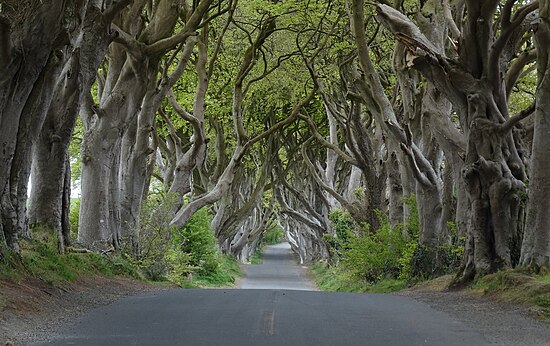
|
|
The Dark Hedges are an avenue of beech trees near Armoy in County Antrim, Northern Ireland. Planted in the late 18th century for the Gracehill House estate of James Stuart, the trees form an atmospheric "tunnel" and became a tourist attraction after their use as a filming location in the HBO television series Game of Thrones. This photograph of the Dark Hedges was taken in 2016. Photograph credit: Colin Park
Recently featured:
|
March 18

|
The saung, also known as the saung-gauk or the Burmese harp, is an arched harp used in traditional Burmese music. It is regarded as the national musical instrument of Myanmar. It was possibly introduced as early as 500 AD from southeastern India, based on archaeological evidence of Burmese temple reliefs that depict a long-necked harp similar to depictions found in Bengal. The earliest evidence of the saung itself is at the Bawbawgyi Pagoda near present-day Prome. At that site, there is a mid-600s sculptured relief depicting the arched harp with about five strings, appearing with musicians and a dancer. It has survived continuously since that time, and has been mentioned in many texts, pictorial representations and Bagan temples. Burmese chronicles describe harps in ceremonial ensembles at medieval Pagan, and female harpists who performed for royals. This 19th-century saung is in the collection of the Metropolitan Museum of Art in New York City. Photograph credit: Metropolitan Museum of Art
Recently featured:
|
March 19

|
Margaret Harwood (March 19, 1885 – February 6, 1979) was an American astronomer who specialized in photometry, which involved measuring variation in the light of stars and asteroids. In 1916, at 30 years old, Harwood was named director of Maria Mitchell Observatory, and worked there until her retirement in 1957. In 1917, she discovered the asteroid 886 Washingtonia four days before its formal recognition, but was advised not to report it because it would have been inappropriate for a woman to do so. In 1923, she became the first woman to gain access to the Mount Wilson Observatory, and in 1924 was the first woman allowed to use the observatory's 60-inch telescope, the largest in the world at the time. In 1960, an asteroid discovered at Palomar was named in her honor as 7040 Harwood. This photograph of Harwood is in the archives of the Smithsonian Institution. Photograph credit: unknown; restored by Adam Cuerden
Recently featured:
|
March 20

|
|
The blue-throated macaw (Ara glaucogularis) is a species of macaw that is endemic to a small area of north-central Bolivia, known as the Llanos de Moxos. Recent population and range estimates suggest that about 350 to 400 individuals remain in the wild. Its demise was brought on by nesting competition, avian predation, and a small native range, exacerbated by indigenous hunting and capture for the pet trade. Although plentiful in captivity, it is critically endangered in the wild and protected by trading prohibitions. In 2014, the species was designated a natural patrimony of Bolivia. This blue-throated macaw in flight was photographed at Loro Parque, on the Spanish island of Tenerife in the Canary Islands. Photograph credit: Carsten Steger
Recently featured:
|
March 21
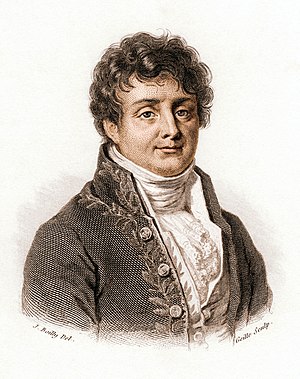
|
Joseph Fourier (21 March 1768 – 16 May 1830) was a French mathematician and physicist born in Auxerre and best known for initiating the investigation of Fourier series, which eventually developed into Fourier analysis and harmonic analysis, and their applications to problems of heat transfer and vibration. The Fourier transform and Fourier's law of conduction are also named after him. He is also generally credited with the discovery of the greenhouse effect. This engraving of Fourier was drawn by Julien-Léopold Boilly, a French artist noted for his album of lithographs titled Iconographie de l'Institut Royal de France (1820–1821) and his booklet Album de 73 portraits-charge aquarellés des membres de l'Institut (1820), containing watercolor caricatures of seventy-three members of the Institut de France. Engraving credit: Amédée Felix Barthélémy Geille, after Julien-Léopold Boilly; restored by Bammesk
Recently featured:
|
March 22

|
The pomelo (Citrus maxima) is the largest citrus fruit from the family Rutaceae and the principal ancestor of the grapefruit. It is a natural, non-hybrid citrus fruit, native to Southeast Asia. Growing on a tree 5–15 meters (16–50 feet) in height, the fruit is 15–25 cm (6–10 in) in diameter with a usual weight of 1–2 kilograms (2–4 pounds) and has a thicker rind than a grapefruit. It is divided into 11 to 18 segments and its flesh tastes like a mild grapefruit, with little of its common bitterness. The fruit generally contains few, relatively large seeds, but some varieties have numerous seeds. Photograph credit: Ivar Leidus
Recently featured:
|
March 23

|
The Tomb of Mian Ghulam Kalhoro is a religious shrine situated in Hyderabad, Pakistan, and the oldest building in the city. It is the burial place of Mian Ghulam Shah Kalhoro, who died in 1772 and is believed to be the founder of Hyderabad, and the second-most important figure in the province of Sindh after Shah Abdul Latif Bhittai. The domed shrine is built inside a rectangular fort, and its interior is decorated with gildings, arc-shaped windows, and tiles. This exterior view of the tomb was photographed in 2020. Photograph credit: Alexander Savin
Recently featured:
|
March 24

|
Gerty Cori (1896–1957) was a Czech-American biochemist. She was the third woman to win a Nobel Prize in science, and the first woman to be awarded the Nobel Prize in Physiology or Medicine, for her significant role in the "discovery of the course of the catalytic conversion of glycogen". Born in Prague, Cori grew up at a time when women were marginalized in science and allowed few educational opportunities, but she nonetheless gained admittance to medical school. With her husband Carl Ferdinand Cori and the Argentine physiologist Bernardo Houssay, she received the Nobel Prize in 1947. This photograph from the Smithsonian Institution Archives, taken in the same year, shows Cori and her husband working in their laboratory. Photograph credit: unknown; restored by Bammesk
Recently featured:
|
March 25
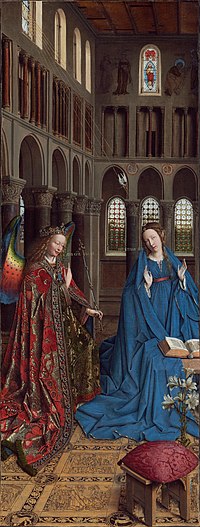
|
The Annunciation is an oil painting by the Early Netherlandish master Jan van Eyck, painted around 1434–1436. Originally on panel, the work was transferred to canvas in the 19th century. It is thought to have been the left (inner) wing of a triptych, although there have been no sightings of the other wings since before 1817. The painting depicts the biblical scene of the Annunciation, in which the Archangel Gabriel announces to the Virgin Mary that she will bear the son of God. The inscription shows his words: AVE GRA PLENA ('Hail, full of grace'). She modestly draws back and responds, ECCE ANCILLA DNI ('Behold the handmaiden of the Lord'); these words appear upside down. The Annunciation is now in the collection of the National Gallery of Art in Washington, D.C. Painting credit: Jan van Eyck
Recently featured:
|
March 26

|
|
Somapura Mahavihara is a Buddhist vihara (monastery) at Paharpur in Badalgachhi, Bangladesh. Built during the reign of the second Pala king Dharmapala (circa 781 to 821), it was one of five great Mahaviharas of the period. It is considered one of the most important archaeological sites in the country and was designated a UNESCO World Heritage Site in 1985. This aerial photograph, depicting the structure of the central shrine of Somapura Mahavihara, was taken in 2021. Photograph credit: Md. Ahsanul Haque Nayem
Recently featured:
|
March 27

|
|
The Fortune Teller is an operetta in three acts composed by Victor Herbert, with a libretto by Harry B. Smith. After a brief tryout in Toronto, it premiered on Broadway on September 26, 1898, at Wallack's Theatre and ran for 40 performances. The star Alice Nielsen and many of the original company traveled to London, where the piece opened at the Shaftesbury Theatre on April 9, 1901, running for 88 performances. This 1905 poster for The Fortune Teller, depicting eight members of the women's drum corps, was presumably produced for a touring or repertoire production by Nielsen's company. Poster credit: United States Lithograph Company; restored by Adam Cuerden
Recently featured:
|
March 28
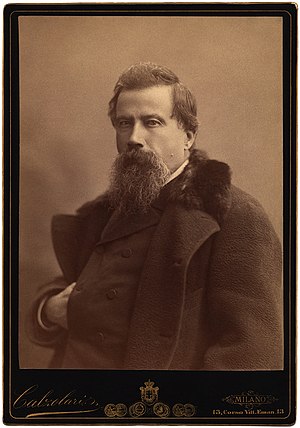
|
Amilcare Ponchielli (1834–1886) was an Italian composer. Born in Paderno Fasolaro (now Paderno Ponchielli) near Cremona, then Kingdom of Lombardy–Venetia, Ponchielli won a scholarship at the age of nine to study music at the Milan Conservatory, writing his first symphony by the time he was ten years old. He is best known for his operas, most notably La Gioconda, the third and most successful version of which debuted at La Scala in Milan on 28 March 1880. The Dance of the Hours from that opera is widely known thanks in part to its use in Walt Disney's Fantasia in 1940 and in Allan Sherman's novelty song "Hello Muddah, Hello Fadduh". In 1881, Ponchielli was appointed the maestro di cappella of Bergamo Cathedral and a professor of composition at the Milan Conservatory, where his pupils included Giacomo Puccini, Pietro Mascagni, Emilio Pizzi, and Giovanni Tebaldini. He was married to the soprano Teresina Brambilla and died at the age of 51 in Milan. This formal photographic portrait of Ponchielli was taken in Milan and is in the archives of the music publisher Casa Ricordi. Photograph credit: Icilio Calzolari; restored by Adam Cuerden
Recently featured:
|
March 29
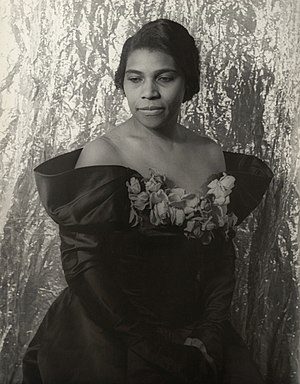
|
Marian Anderson (1897–1993) was an American contralto. She performed a wide range of music, from opera to spirituals, in major concert and recital venues between 1925 and 1965. Anderson was an important figure in the struggle for African-American artists to overcome racial prejudice in the United States during the mid-twentieth century. In 1939, after being prohibited from performing for an integrated audience in Constitution Hall in Washington, D.C., First Lady Eleanor Roosevelt and her husband President Franklin D. Roosevelt arranged for Anderson to perform in an open-air concert on Easter Sunday on the Lincoln Memorial steps in the capital which was broadcast to a radio audience of millions and was featured in a documentary film. In 1955, Anderson became the first African-American singer to perform at the Metropolitan Opera. She worked as a delegate to the United Nations Human Rights Committee and as a Goodwill Ambassador for the United States Department of State, giving concerts all over the world. She participated in the civil rights movement in the 1960s, singing at the March on Washington for Jobs and Freedom in 1963. The recipient of numerous awards and honors, Anderson was awarded the first Presidential Medal of Freedom in 1963, the Congressional Gold Medal in 1977, the Kennedy Center Honors in 1978, the National Medal of Arts in 1986, and a Grammy Lifetime Achievement Award in 1991. This portrait photograph of Anderson in a formal gown was taken in 1940. Photograph credit: Carl Van Vechten; restored by Adam Cuerden
Recently featured:
|
March 30
The Papiermark is the name given to the German currency from 4 August 1914, when the link between the Goldmark and gold was abandoned. In particular, the name is used for the banknotes issued during the period of hyperinflation in the Weimar Republic in 1922 and especially 1923. During this period, the Papiermark was also issued by the Free City of Danzig. The last of five series of the Danzig mark was the 1923 inflation issue, which consisted of denominations of 1 million to 10 billion issued from August to October 1923. The Danzig mark was replaced on 22 October 1923 by the Danzig gulden. This set of Danzig banknotes, in denominations of 100, 500 and 1000 mark, was issued in 1922. These banknotes are part of the National Numismatic Collection at the Smithsonian Institution's National Museum of American History. Banknote design credit: Free City of Danzig; scanned by Andrew Shiva
Recently featured:
|
March 31

|
Jessica Meir (born 1977) is an American-Swedish NASA astronaut, marine biologist, and physiologist. She was previously an assistant professor of anesthesia at Harvard Medical School and Massachusetts General Hospital, Boston, following postdoctoral research in comparative physiology at the University of British Columbia. She has studied the diving physiology and behavior of emperor penguins in Antarctica, and the physiology of bar-headed geese, which are able to migrate over the Himalayas. Meir launched on September 25, 2019, to the International Space Station onboard Soyuz MS-15, where she served as a flight engineer during Expedition 61 and Expedition 62. On October 18, 2019, Meir and Christina Koch became the first women to participate in an all-female spacewalk. Photograph credit: Robert Markowitz
Recently featured:
|
Picture of the day archives and future dates




